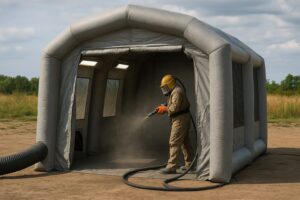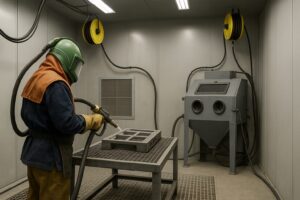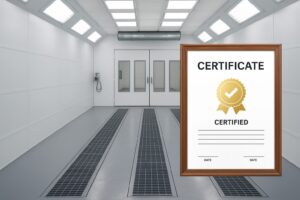When it comes to a professional paint job, whether you’re spraying a vehicle, furniture piece, or industrial part, the final result is only as good as the preparation. Think of the paint booth as the stage and the prep work as rehearsal. If you rush through the prep, the final look may fall flat. But with proper care and attention to detail before the item even enters the booth, you can expect a clean, durable, and smooth finish. Let’s walk through what it takes to properly prepare for the paint booth, whether you’re a seasoned technician or someone stepping into the world of painting for the first time.
Why Prep Matters So Much
You might assume the magic happens inside the booth, with all the high-tech ventilation, perfect lighting, and controlled environment. And you’d be partly right. But if the surface isn’t ready, free of dirt, grease, old paint, or damage, all those booth features won’t save the job.
Paint doesn’t just stick to a surface. It bonds. And for a strong bond, the surface needs to be clean, smooth, and ready to accept that new layer. Without proper prep, paint can peel, bubble, or wear out fast. So, whether it’s a car, bike, cabinet, or equipment panel because preparation is everything.
Step 1: Inspect the Item Thoroughly
Before you even touch a sander or cloth, take a full walk-around. Look at the item or vehicle from every angle. Check for:
- Dents or surface imperfections
- Rust spots or corrosion
- Previous paint failures (peeling or flaking)
- Dirt or grease build-up
This first inspection helps you plan the prep work more efficiently. It also ensures you’re not missing any problem areas that could resurface after painting.
Step 2: Wash and Degrease
It might sound basic, but a good wash is the foundation. Use a degreasing soap or surface prep cleaner to remove:
- Oils
- Road grime
- Waxes or silicone products
- Dust and dirt
Even if something looks clean, microscopic residues can ruin a paint job. Using clean water and a lint-free cloth or sponge, thoroughly wash every inch. Then rinse and dry it completely.
Once dry, go over it again with a solvent-based wax and grease remover. Always use lint-free towels, and never reuse rags that have been contaminated with oils or dirt.
Step 3: Sand and Smooth
Next, it’s time to prepare the surface for paint adhesion. This often means sanding.
- For vehicles, a dual-action (DA) sander is a great tool.
- For flat items or small parts, manual sanding may be enough.
The grit level depends on the type of paint being used and the current condition of the surface. A common approach is to start with 320-400 grit to remove gloss or old paint. The goal isn’t to remove all previous paint—just to dull the surface enough for the new coat to grip.
If there are imperfections, now is the time to use body filler, spot putty, or primer surfacers. These must be sanded smooth and blended into the surrounding area.
Step 4: Mask and Protect
You don’t want paint ending up on areas like trim, glass, rubber, or hardware. Use high-quality masking tape and masking paper to carefully cover:
- Windows
- Lights
- Wheels or tires (for vehicles)
- Seams and edges are not meant to be painted
Avoid using newspaper or cheap tape, as they can bleed or fail under paint booth conditions.
For small parts or items, you can hang them in the booth using wire or place them on stands. Just be sure nothing blocks the spray pattern.
Step 5: Final Wipe-Down
Before heading into the booth, do a last clean-up. This includes:
- Using a tack cloth to pick up fine dust
- Wiping with a clean, dry microfiber cloth
- Checking for fingerprints or smudges
Even a small bit of lint or oil can show up as a blemish in the final coat. Take your time here, it’s the last step before the painting begins.
Also, make sure the surface temperature is right. If it’s too cold or humid, condensation can interfere with paint adhesion. Most professional booths control this, but double-check your environment just in case.
Step 6: Safety and Equipment Check
Preparation isn’t just about the item, it’s about you and the workspace. Before starting the painting process, ensure:
- You’re wearing proper safety gear (respirator, gloves, goggles)
- The booth is clean and free of debris
- Air filters are functioning properly
- The spray equipment is clean and adjusted
If you’re handling the spraying yourself, do a quick test spray on cardboard or scrap material to check the flow and fan pattern. If you’re handing it over to a paint professional, your role is now complete, and the booth can take over.
What Not to Do
A few common mistakes can undo hours of prep:
- Skipping degreasing: Paint can’t stick to oil or wax.
- Sanding inconsistently: You’ll see uneven texture once the paint is applied.
- Leaving behind dust or fibers: These can cause bumps, pinholes, or fish eyes in the paint.
- Using cheap masking materials: Paint can seep through or leave unwanted residue.
Rushing into the booth: Always double-check everything. It’s better to wait five minutes and be sure than to fix a flaw after painting.
The Bottom Line
Whether you’re prepping a motorcycle tank, a kitchen cabinet, or an entire car, the paint booth is where precision and craftsmanship come together. But even the most advanced booth can’t overcome poor prep. A clean, sanded, and properly masked item lays the groundwork for excellence.
The time you invest in preparation will always show in the end resultlike glossy, smooth, and durable finishes that last. So take a breath, follow each step with care, and give your paint booth the best possible starting point. Great results start before the spray gun even turns on.
How We Can Help with Your Paint Booth Needs
At Paint Booth, we specialize in providing top-tier paint booths and finishing equipment tailored to your business requirements. Whether you need a standard-size paint booth or a custom solution designed for your unique projects, our expert team is here to assist you every step of the way. From design to installation, we ensure that your equipment meets the highest industry standards, enhancing both your productivity and the quality of your finishes. Contact us today to find the perfect paint booth solution for your business!




